WordPress Glossary Plugin (CMTG) + Community Terms (CMTCT) - Use Case - Letting Users Edit Existing Glossary Terms
Use Case - Letting Users Edit Existing Glossary Terms
Note: This use case require these products to be activated:
- WordPress Glossary plugin (Pro, Pro+ or eCommerce) - This document uses eCommerce version 4.3.8.
- Glossary Community Terms Submission Add-On - This document uses version 1.3.2.
Introduction
The Glossary Community Terms Submission add-On allows users to suggest terms to your glossary.
Use Case Front-End
Editing an existing term created by another user:

Moderating term changes suggestions:

Use Case Assumptions
In this example use case guide, we'll cover how to let users edit their own terms and suggest edits for other existing terms.
We consider that you have already bought the add-on, but not installed it. The WordPress Glossary plugin is used as a base plugin.
It follows:
- Installing the add-on
- Quick recap
- Initial conditions
- Suggestion form
- Let users edit their own terms
- Let users edit terms created by other users
- Translating front-end labels
- Extra - ReCaptcha
- End result
Installing the Add-on
The process is the same for all CM plugins.

- Download the plugin from your customer dashboard.
- Log in to WordPress and navigate to the WordPress Admin → Plugins settings.
- Click on Add New.
- Activate it and add the license.
Quick Recap
In this use case guide we will focus mostly on editing existing terms. Of you want to start with the basics of setting up the basic plugin and add-on, please check the following use case guides:
Initial Conditions
There's a difference in the editing process for when the user edits a term that was created by him and when the user tries to edit a term created by another user.
First difference is that when the user suggests edits for a term which is created by somebody else, he can suggest changes only for the definition - other fields like Synonyms, Abbreviations and others are not available in this case.
Second difference is that when the user edits a term created by him, the changes are applied without any moderation. Otherwise the admin should review the suggestion, then either accept or reject it.
Let's start with enabling all additional fields in the suggestion form.
Suggestion Form
Navigate to Admin Dashboard → CM Tooltip Glossary → Settings → Community Terms tab.
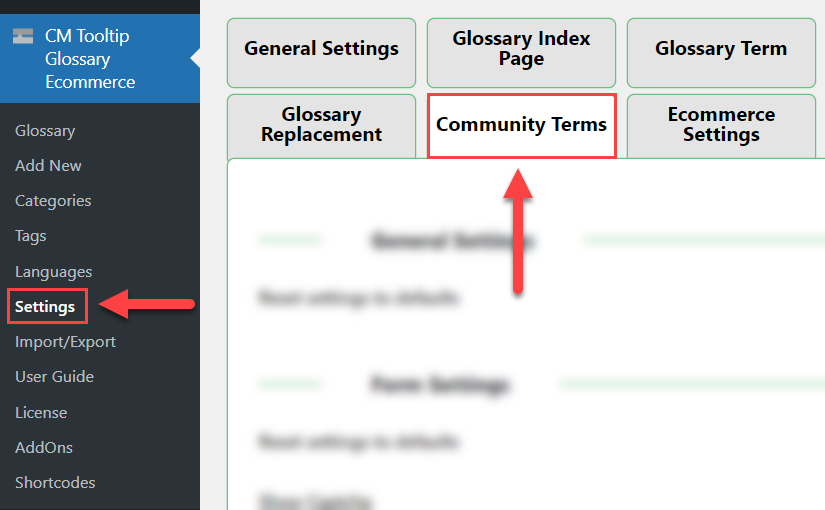
Scroll down and find the section Form Labels & Placeholders. Here you can optionally enable the following form fields - the ones that you want to be displayed in the suggestion form:
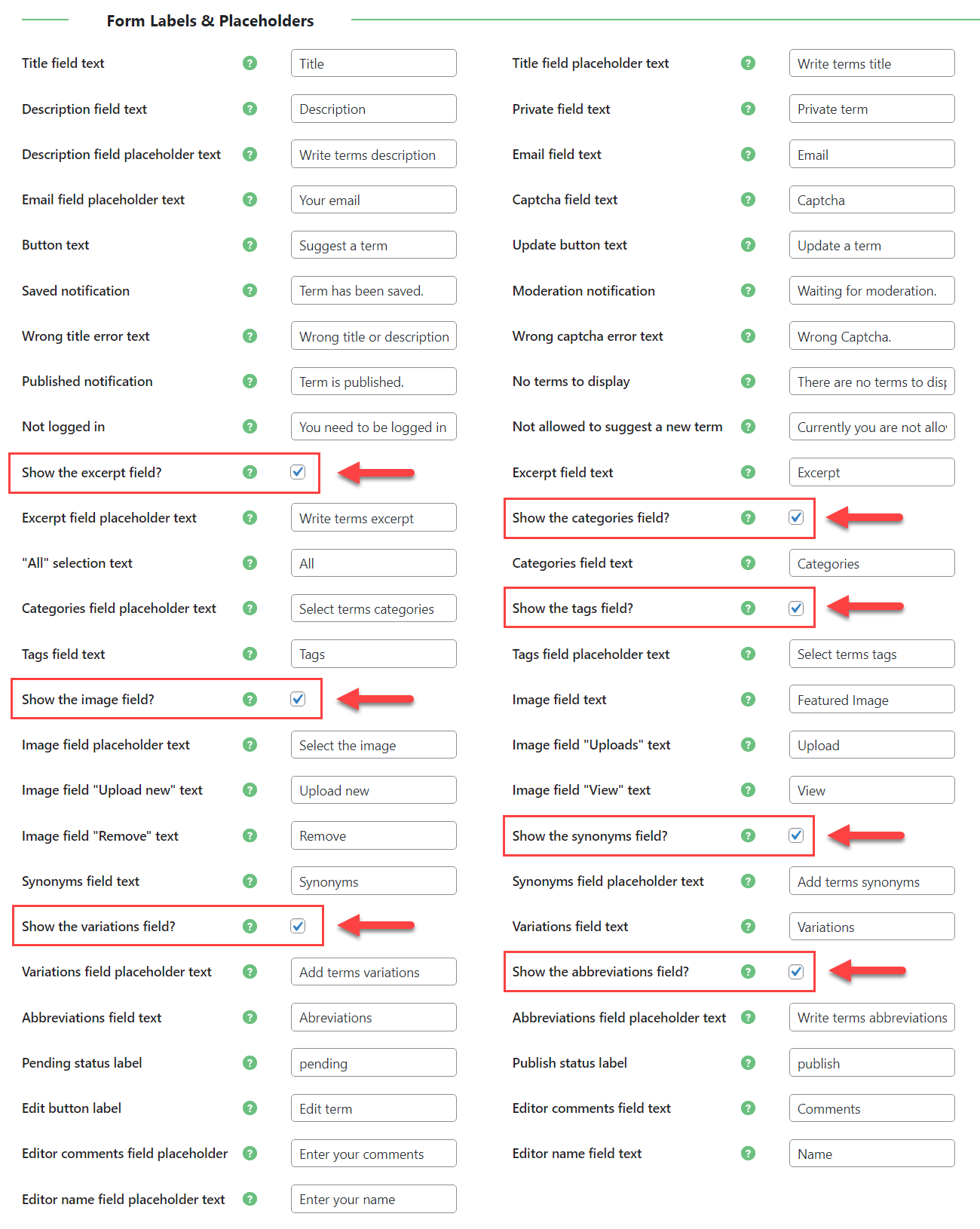
- Show the excerpt field
- Show the categories field
- Show the tags field
- Show the image field
- Show the synonyms field
- Show the variations field
- Show the abbreviations field
Here's how the suggestion form will look like with all enabled fields:

Let Users Edit Their Own Terms
To let users edit their own terms, we need to configure the following. First of all, the user should be allowed to add new terms. For that, you need to select the needed user roles in the option Who can add terms under the Moderation Settings section.

Next, under the section Edit Terms, you need to enable the option Allow users to edit their own terms. Optionally, you can also let users remove their terms by enabling the option Allow user to delete terms.

Now Save Changes by clicking the relevant button:

Users will be able to edit and delete their terms from their terms dashboard.
TIP
To display a terms dashboard on the front-end, you need to place a shortcode [terms_dashboard] on the needed page.
Learn more about the plugin shortcodes: CM Tooltip Glossary Community Terms (CMTCT) - Shortcodes
Front-end Result
Now when the user reviews a dashboard with created by him terms, he will see 2 additional columns that allow to edit or delete his terms:
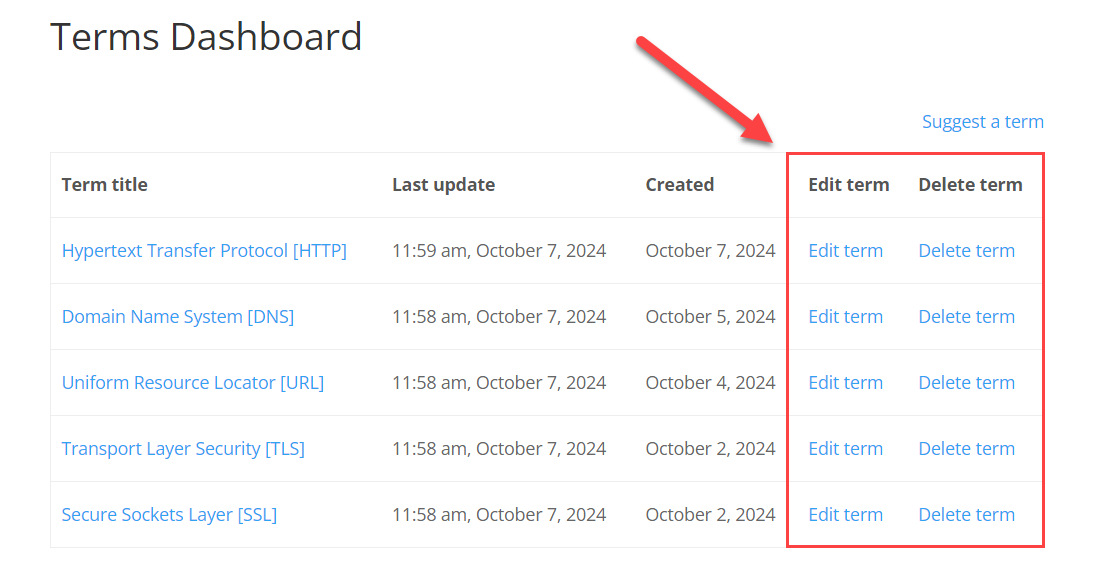
Clicking Edit term will show the same suggestion form where the user can edit all fields of his term:
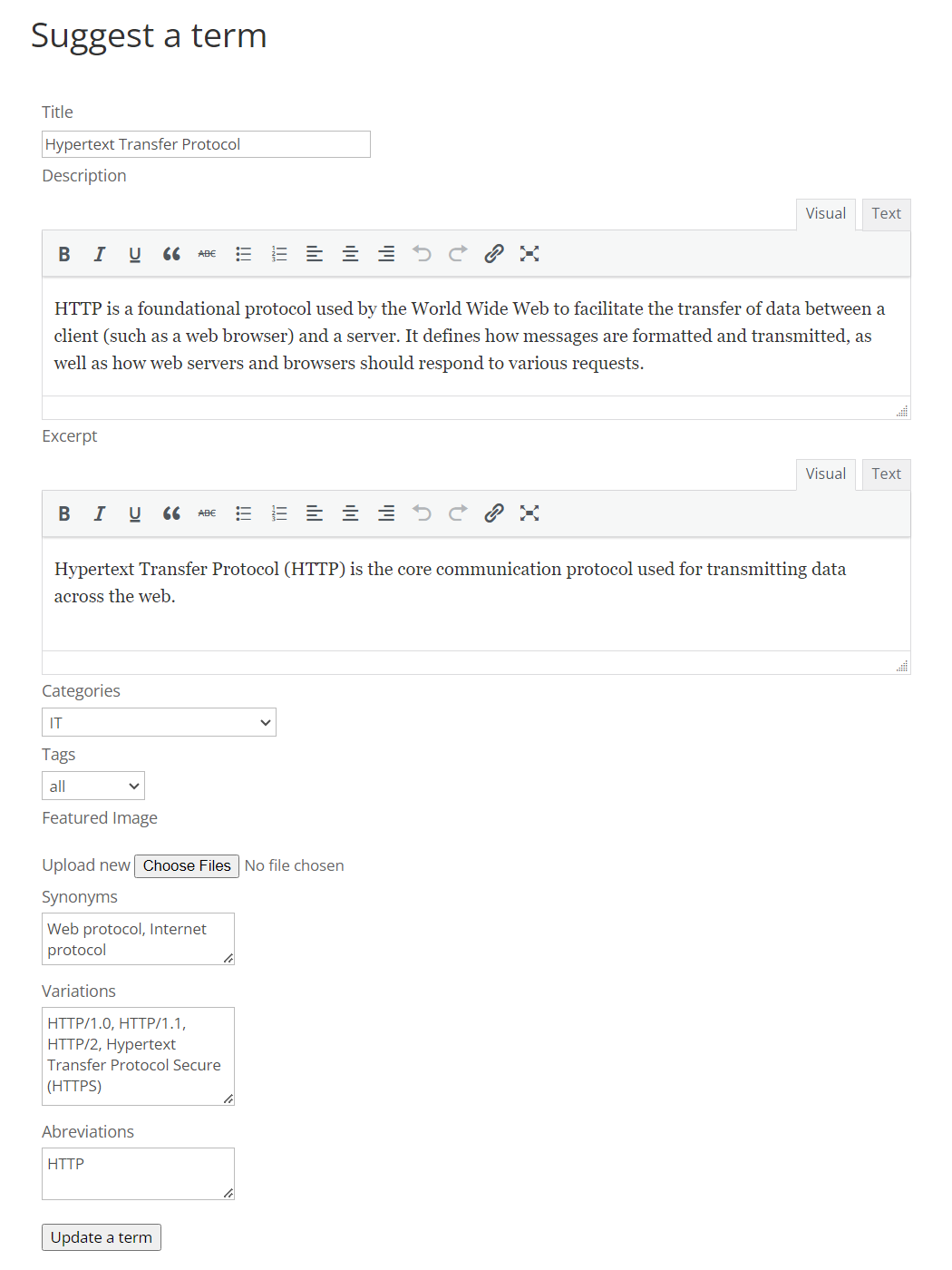
When the user edits a term created by him, the changes are applied immediately, without any moderation.
Let Users Edit Terms Created By Other Users
Users can suggest edits for terms created by somebody else. For that, under the Edit Terms section, select needed user roles in the option Who can suggest editing a term:

Important
Have a note that to let users suggest edits for terms must also be allowed to suggest new terms.

It does not mean that in both options should be selected all the same roles. For example, you can let user roles Author, Contributor and Subscriber suggest new terms, but let only the user role Author to suggest edits for terms.
Don't forget to save the changes after selecting user roles that you want to allow suggest edits for terms.
Front-end Result
Now users will see a link Edit term when viewing any term page:
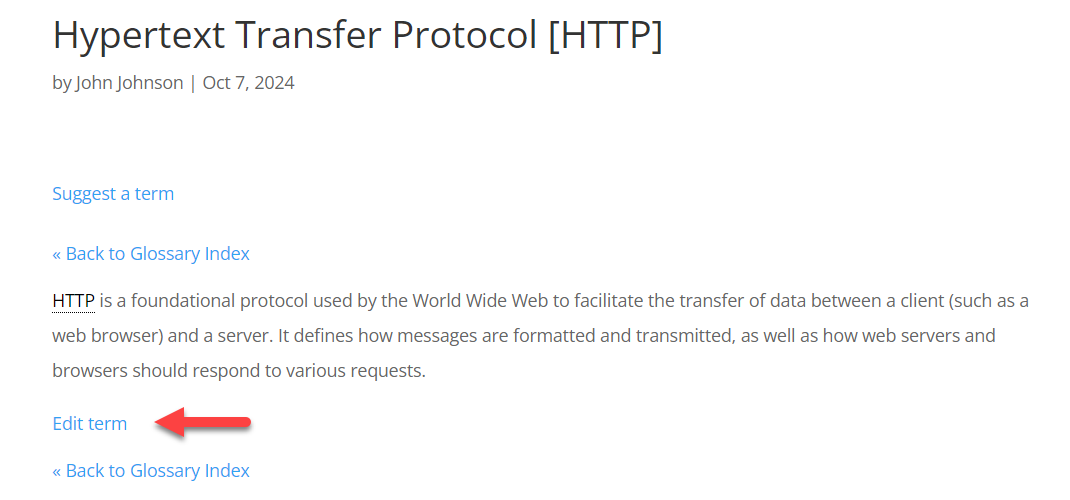
Clicking on this link will redirect to the simplified suggestion form. When a user edits a term created by somebody else he can only edit the term description, add a comment about his suggestion, and provide his email and name.

After clicking the button Update a term, the suggestion will be held for admin moderation.
Moderating Term Edits
As an admin, to find a dashboard for moderating term edit suggestions, navigation to Admin Dashboard → CM Tooltip Glossary → Edits Offers.
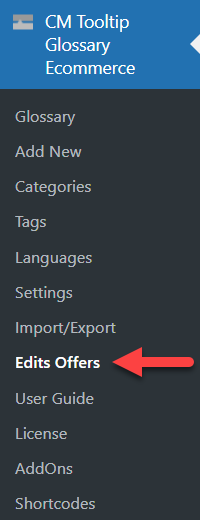
There you will see a table with the following columns:

- Post Title - Contains a link to the term which received an edit suggestion.
- Current Content - Shows a definition that is currently published for the term.
- Suggested Content - Shows an updated definition for the term.
- Editor Name - Shows the name of the user who suggested to edit the term.
- Editor Email - Shows the email of the user who suggested to edit the term.
- Comments - Shows the comment that the user left about the changes he offers.
- Actions - This column has 2 buttons for the admin to make a decision: either Accept the changes or Reject.
Email Notifications
When the user suggests changes for a term created by another user, the admin can receive an email notification. Once the admin accepts or rejects the suggestions, the user who suggested changes can also receive an email notification about his suggestion status.
The plugin provides email templates for that. To configure them, get back to the Community Terms tab.

Find the section Notification Settings. You can find there 2 relevant email templates. Let's consider each of them a bit more detailed.

Edit Term Suggestion
- Admin email notification about edit - Enable this option if you want to receive email notifications when new term edits has been suggested.
- Admin email notification about edit suggestion subject - Define the email notification subject.
- Admin email notification about edit suggestion text - Define the email notification text. You can use the tag [term] to display the term name.
Edited Term Status Change
- Editor email notification - Enable this option if you want users who suggested an edit to receive email notifications when the edit is accepted or rejected.
- Editor email notification subject - Define the email notification subject.
- Editor email notification text - Define the email notification text. You can use the tag [term] to display the term name, and [old] and [new] to display the term status before and after moderation.
Translating Front-end Labels
All front-end labels related to the form for suggesting new terms or changes for existing terms can be changed or translated to another language. You can find needed labels under 2 sections: Community terms labels and Form Labels & Placeholders.
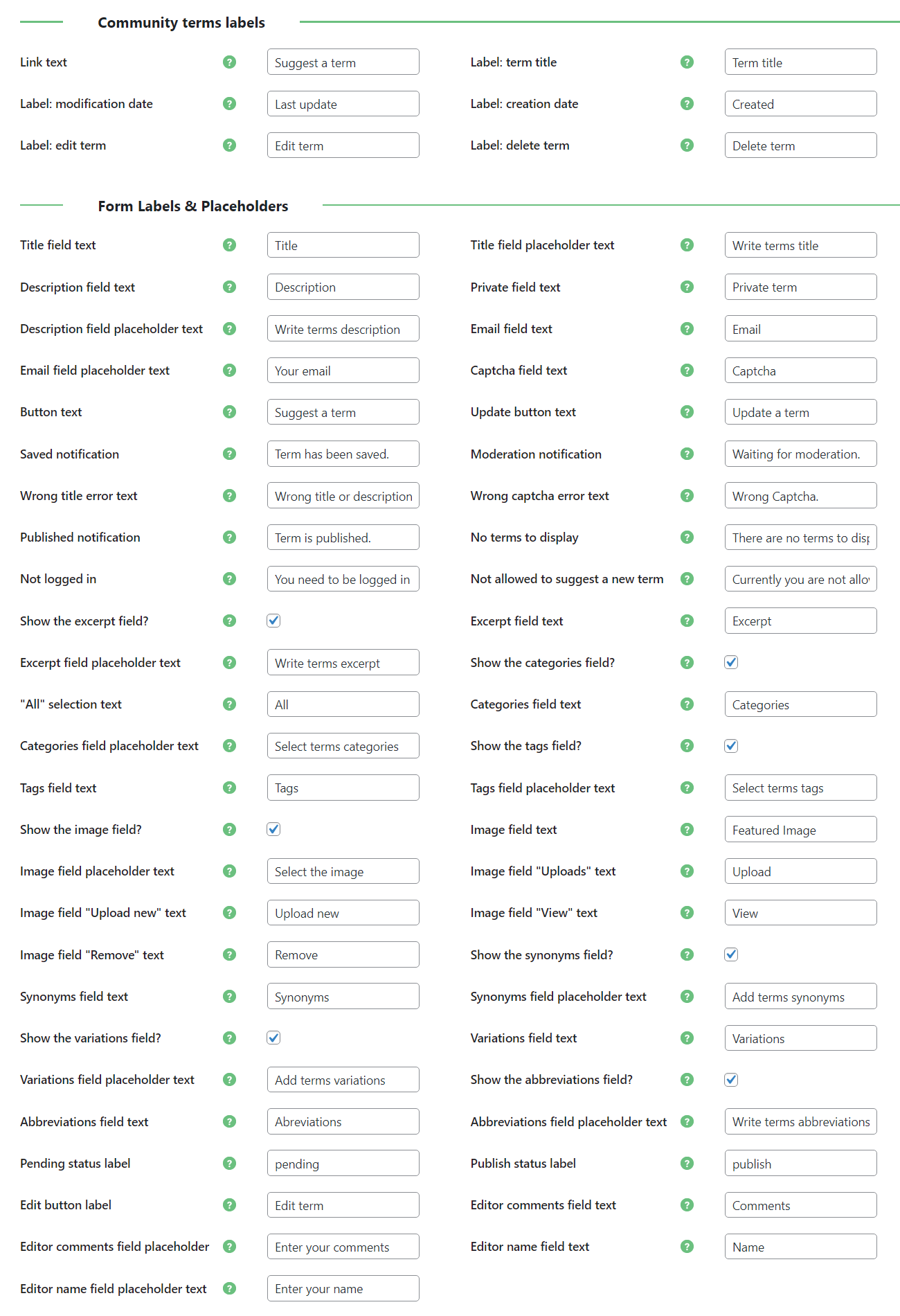
Extra - ReCaptcha
You might want to add an additional layer of security to protect from bots, especially if you want to allow guest users (not registered) to suggest new terms or edit the existing ones.
It can be done by enabling reCaptcha in the suggestion form. To do this, head to the Form Settings section. Here you need to:

- Show Captcha - Turn on this option to enable the Captcha feature.
- Captcha key / Captcha secret key - Enter Captcha key and Captcha secret key. The keys can be obtained here.
Front-end Result
As a result, the user will have to complete reCaptcha in the suggestion form:
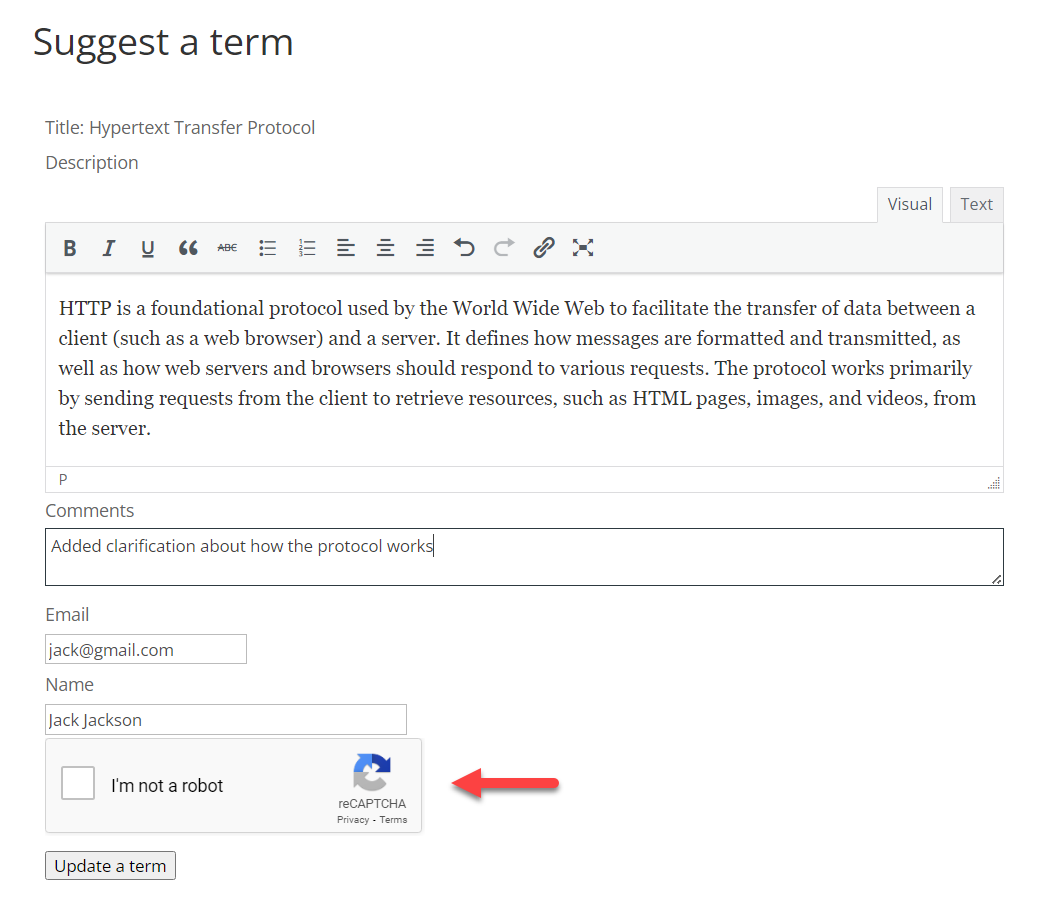
End Result
Following instructions found in the plugin and guides, you should be able to let users edit their own terms and suggest edits for other existing terms.
Use Case Front-End
Editing an existing term created by another user:

Moderating term changes suggestions:

 |
More information about the Glossary Community Terms add-on for WordPress Other WordPress products can be found at CreativeMinds WordPress Store |
 |
Let us know how we can Improve this Product Documentation Page To open a Support Ticket visit our support center |
